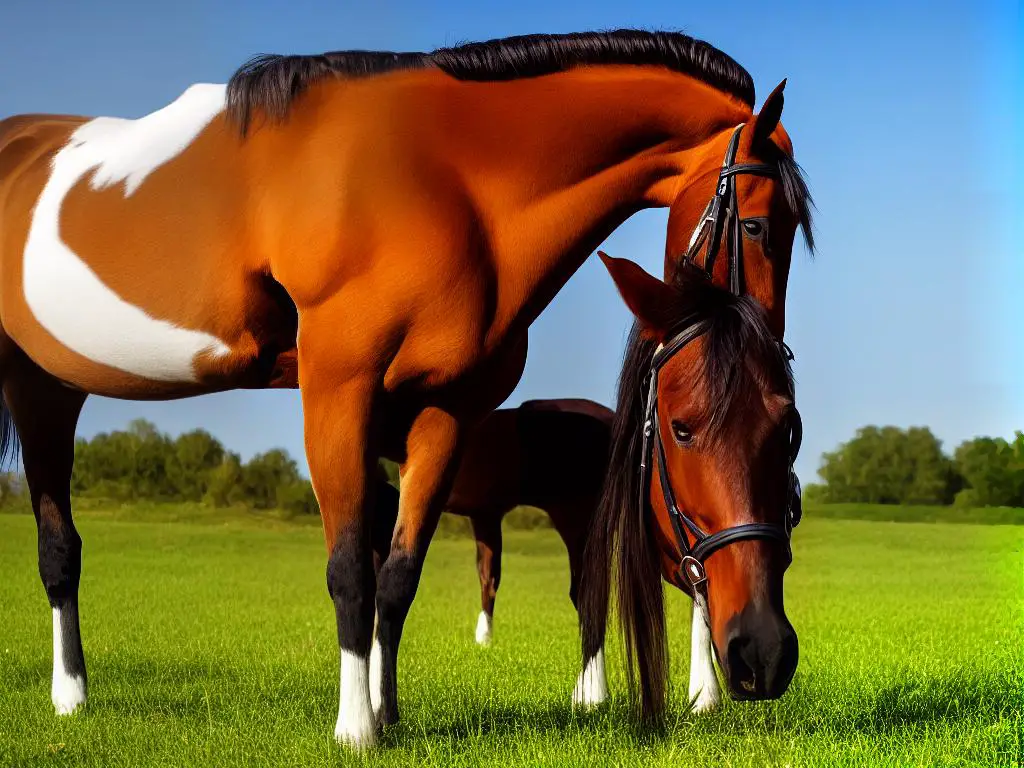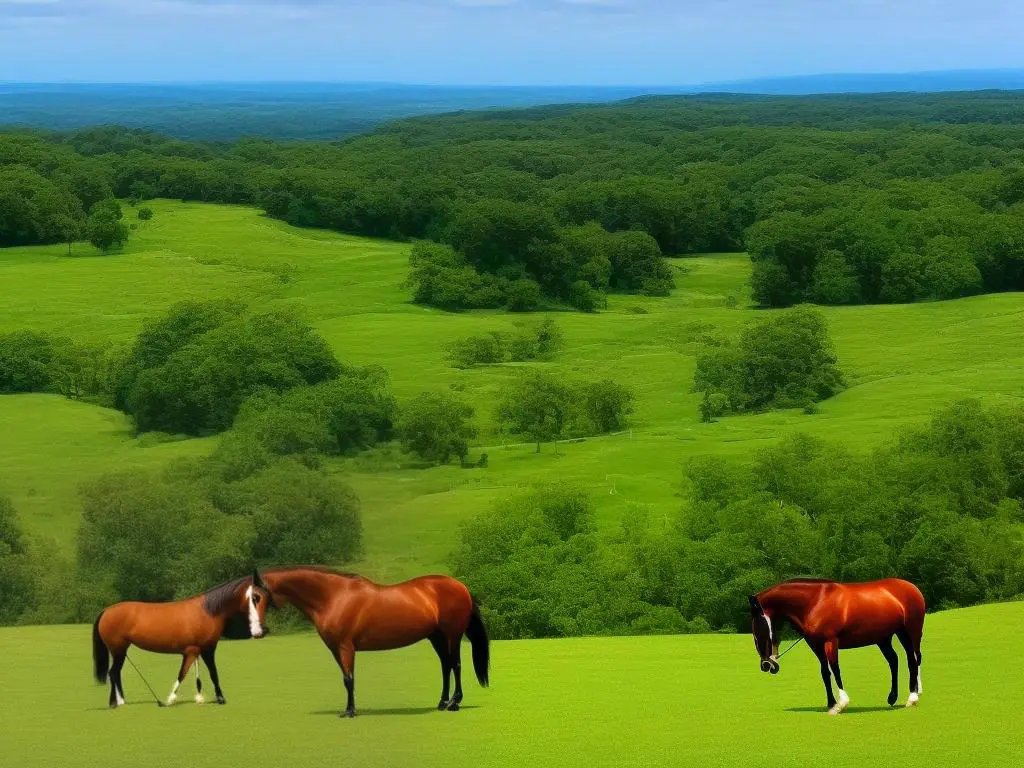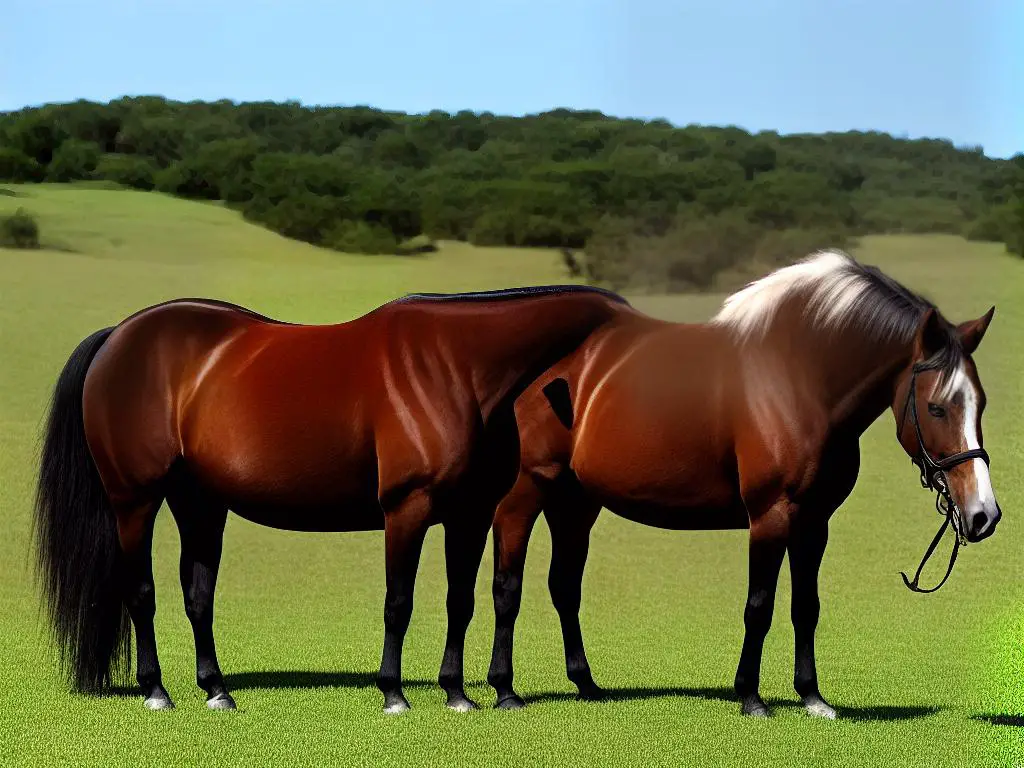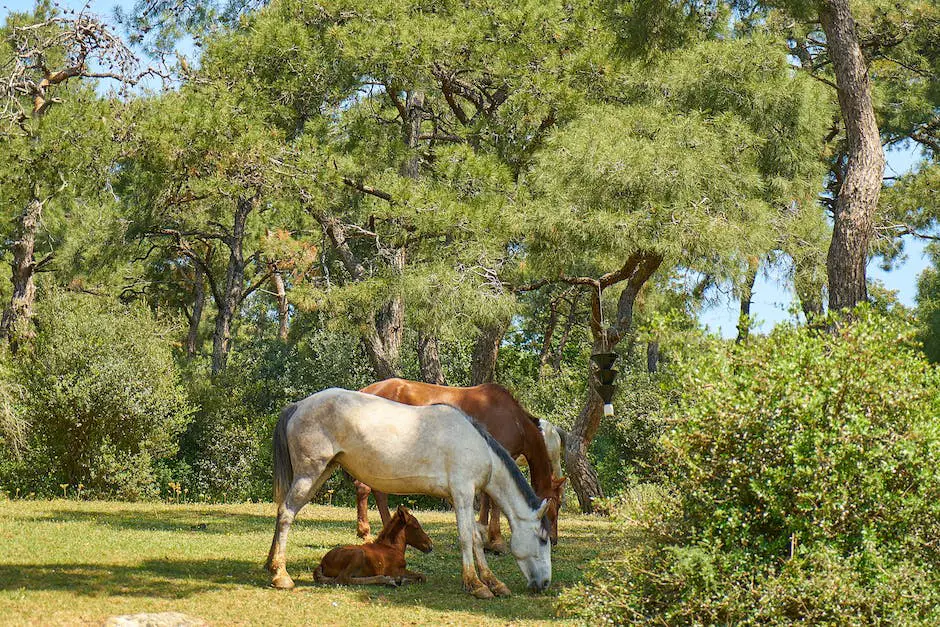Horses, known for their elegance and power, have been intertwined with human society for centuries, serving as loyal companions, workforce, and more recently, as sports and leisure animals. Yet, among the hundreds of horse breeds globally, few can match the versatility and character of the Norman Cob. This, coupled with a fascinating history and physical characteristic, makes them stand out from the crowd. This discussion offers a comprehensive look into the Norman Cob breed, their history, physical attributes, and uses, as well as how to care for these magnificent creatures and the efforts put toward their preservation and breeding.
Table of Contents (Horspedia)
Origins and History of the Norman Cob
Origins and Early History of the Norman Cob
The Norman Cob, also known as Cob Normand, is a versatile horse breed with roots tracing back to the Normandy region in northern France. While horses have been bred in Normandy for centuries, the breed as we know it today began to take shape in the late 19th and early 20th centuries. Originating mainly from Ardennais and Percheron drafts that local farmers crossed with Trotteur Français (standardbred) to produce a robust and agile breed, the Norman Cob was initially bred for both agricultural work and harness racing.
In the early days, the Norman Cob served multiple purposes, including transportation and farm work. They were highly valued for their strength, endurance, and temperament, making them an indispensable part of rural life in Normandy.
Evolution of the Breed
As technologies changed and the demand for draft horses decreased, the role of the Norman Cob also began to evolve. While early specimens of the breed were stouter and heavily muscled, suitable for hard labor, breeders started focusing on producing a lighter, more refined animal for riding and driving sports.
This transition was facilitated by the introduction of Thoroughbred and Trotteur Français bloodlines. These breeds contributed to the Norman Cob’s improvement, resulting in a more athletic and versatile horse with a great aptitude for speed under harness.
Modern Day Norman Cob
Today’s Norman Cobs are known for their versatility, hardiness, and solid build. Standing at 15.2 to 16.3 hands high, they possess a broad chest, strong back, and well-muscled hindquarters. They come in all solid colors, but bay and chestnut are the most common.
Recognized for their calm temperaments and eagerness to please, Norman Cobs excel at a variety of equestrian sports, including harness racing, show jumping, dressage, and eventing. Furthermore, their strength and endurance make them ideal for farm work or as carriage horses.
Despite their change in roles, Norman Cobs still retain the qualities that made them esteemed work horses: robustness, diligence, and resilience. No longer limited to their native Normandy, these horses have won international acclaim and can be found in many parts of the world.
Looking Back
The history of the Norman Cob provides remarkable insight into the world of agriculture and equestrian endeavors. Originating from the vast fields of Normandy, and now donning the fields of professional equestrian sports, these horses have admirably demonstrated adaptability and resilience. This progression serves as a testament to the evergreen popularity of this breed, and its ability to stand the test of time.

Physical Characteristics and Traits of the Norman Cob
Spotlighting the Norman Cob’s Physique
Characterized by a robust and compact frame, the Norman Cob came by its attention naturally because of its overall powerful appearance. Normally, they stand between 15.2 to 16.3 hands high, in other words, their stature lies somewhere around 62 to 67 inches from the ground to the highest point of their withers (the ridge between their shoulder area). This makes them a sizeable horse breed.
Their compact bodies are extraordinarily muscular, particularly in the neck, chest, and hindquarter regions. These muscular zones, in conjunction with a wide chest, hardy shoulders, and robust limbs, accentuate their overall strong presence. Their heads are expressive, featuring a square shape, and are mounted on potent, medium-length necks. With their large, soulful eyes and ears of modest size, they make quite an endearing sight.
The coat of Norman Cobs can present in multiple colors, with bay, chestnut, and black being the most common. However, different solid colors can be observed too, though the breed standard excludes any picks with spotted or pinto patterns. They typically have extensive mane and tail hair, with featherings around their hooves that are heavier than most other equine breeds. These features contribute to their unique and eye-catching look.
Exploring Attributes and Temperament of the Norman Cob
Norman Cob horses are not just about looks, they also possess a bundle of personality traits alongside their performance abilities, which are deemed attractive for various uses.
These horses are typically calm and mild-mannered, which coupled with their readiness to work, endear them to novice and inexperienced horse handlers. Their affable nature also allows them to adapt quickly and respond favorably to training, making them a suitable breed for families and young ones.
The Norman Cobs are highly regarded for their impressive pulling strength, endurance, agility, resilience, and adaptability. They exhibit high levels of energy and drive when given tasks, in line with their intrinsic strength and stamina. Because of their rugged build and potency, they were historically employed for agricultural tasks like pulling carts and plowing fields. Currently, they engage in varied activities such as dressage, show jumping, eventing, and driving, thereby displaying their versatility on the field.
In spite of their tough exterior, these horses are surprisingly agile and graceful. These traits, along with their smooth gait, make them suitable for a variety of riding disciplines.

Uses of the Norman Cob Horse
A Historic and Versatile Breed: The Norman Cob Horse
The Norman Cob hails from Normandy, France, and is esteemed for its robust constitution and extraordinary stamina. Since their inception, these horses have served multiple roles, both on the farm and as trusted modes of transport.
During the 19th and early 20th centuries, Norman Cobs were integral to farm life, performing varied task such as field ploughing and heavy cart towing. Despite advancements in mechanized farming, the Norman Cob’s robustness and resilience keep them relevant in modern rural and traditional settings.
Norman Cob in Sports
This breed’s athletic ability and level-headed nature extend beyond the farm. Norman Cobs are known for their versatility in equestrian sports. Their calm temperament, combined with inherent strength and stamina, makes them excellent candidates for competitive driving. This breed is also quite capable in jumping, dressage, and trail riding activities, making them an ideal choice for a diverse range of equestrian sporting events.
Role in Transportation
Historically, the Norman Cob’s strength and sizable frame were utilized in the transportation sector, particularly for hauling heavy goods over long distances. While their use in this regard has lessened with the advent of motorized vehicles, Norman Cobs can still be seen in rural areas or special events, offering nostalgic reminders of the past. Their continued use in areas like horse-drawn tours speaks volumes about their enduring reliability.
Norman Cob for Leisure and Therapy
The Norman Cob’s calm nature makes them excellent horses for leisurely rides and therapeutic horseback riding. Their patient demeanor makes them suitable for novice riders and young families looking to enjoy a peaceful countryside ride. Moreover, therapeutic riding programs have found Norman Cob horses are an exceptional match for their needs, offering a gentle, steady ride that can help people with physical and psychological challenges.
Suitability for Different Types of Riders
The temperament of the Norman Cob horse allows for a wide range of riders to enjoy this breed. Their calm and steady disposition makes them an excellent choice for novice riders, who can learn and progress from these easygoing horses. More experienced riders looking for a reliable, versatile horse for farming, sports, or leisure are also likely to appreciate the Norman Cob’s capabilities.
Exploring the world of the Norman Cob horse breed, one can see its adaptability and versatility shining through. Known for their ability to excel in several roles, from farm work to leisure and therapeutic activities, their wide range of applications makes them a favorite among different types of equestrians. Their solid build not only adds to their aesthetic appeal but also equips them for a variety of tasks, making them suitable for sports, recreation, and transportation.

Health and Care for Norman Cob Horses
Understanding Health Complications in Norman Cob Horses
While the Norman Cob breed exhibits strength and robustness, it is not immune to health issues, just like other horse breeds. A common concern among these horses can be obesity, stemming from their reputation as easy-keepers. This can lead to equine metabolic syndrome, increasing their risk for laminitis, a painful hoof condition. Additionally, they could also be prone to respiratory ailments and skin diseases. Through regular veterinary check-ups and proper care, it’s possible to prevent or manage most of these health risks effectively.
Dietary Needs of Norman Cob Horses
Norman Cob horses are known for their efficient metabolism. They can maintain their weight with less food than more high-strung breeds. Their diet should consist primarily of forage, like hay and grass, which should make up 1% to 2% of their body weight daily. Commercial feeds or grain can supplement the diet if needed, but it should be used sparingly, especially if the horse is prone to obesity.
Because Norman Cobs are predisposed to equine metabolic syndrome, their sugar and starch intake needs to be monitored. Overconsumption of these can lead to weight gain and increase the risk of laminitis. A balanced diet with vitamins and minerals is also important for the overall health of the horse.
Lifespan of Norman Cob Horses
Norman Cob horses are known for their longevity and can live anywhere between 25 to 30 years, sometimes even longer with proper care. Regular vet checks, a balanced diet, appropriate exercise, and prompt attention to health problems are key to prolonging a Norman Cob’s lifespan.
Tips on Caring for a Norman Cob Horse to Maintain Its Optimal Condition
Effective care for a Norman Cob horse involves a routine that consists of feeding, grooming, and regular exercise. Steady grooming aids in keeping the horse clean and snug, while also providing an opportunity to look for signs of health concerns such as skin diseases or laminitis. Regular hoof cleaning is crucial for the horse, to remove harmful elements such as stones, dirt or debris that could lead to injury or infection.
Exercise is crucial for this breed, to prevent the onset of obesity. However, the intensity of the activity should align with the horse’s age, level of fitness, and general health. Young and energetic horses may require rigorous and frequent exercise compared to the older ones.
Proper shelter is a necessity for the horse, to safeguard it from harsh weather conditions, and clean, fresh water must always be accessible. A balanced diet, frequent vet checkups, and vaccinations form the cornerstone of preventative health care. With a careful approach to veterinary care, a nutritious diet and ample exercise, a Norman Cob Horse can bring a lot of joy to its owner for several years.

Breeding and Preservation of the Norman Cob
The Current State of the Norman Cob Breed
The Norman Cob horse breed originates from the Normandy region in France. It has steadily gained recognition and popularity over time due to its impressive strength, adaptability, exemplary temperament, and unique appearance. Although its numbers aren’t as abundant as some other breeds, the Norman Cob has a dedicated fanbase and has been well-preserved.
Nonetheless, the Norman Cob, like several other horse breeds, faces challenges in maintaining its genetic variety and sustainability. The breed’s relatively small population and restricted geographical spread may put its future health and survival at risk.
Efforts Towards Preservation
Although the preservation efforts for the Norman Cob breed are intensified, it stands as a priority for many horse enthusiasts and breeders both in France and globally. Numerous local and international organizations, such as the Norman Cob Horse Society (Société du Cheval de Trait Normand), dedicate their efforts to promote the breed and support breeding programs. They work tirelessly to raise awareness, organize competitions, and provide breeders with the resources they need to maintain the health and diversity of this breed.
These groups also focus on educating the public about the unique qualities and amazing versatility of the Norman Cob. Displays, horse shows, and other public events are often used to showcase these horses and to introduce people to their history and tradition.
Breeding Methods and Considerations
The breeding of the Norman Cob follows a strategic approach, designed to maintain the breed’s qualities while also maximizing its genetic diversity. Breeders carefully select broodmares and stallions based on certain criteria, such as temperament, physical attributes, health, and overall performance.
Breeders also have to ensure that the matings are not closely related to minimize the risk of inbreeding, which can lead to various health problems and loss of genetic diversity. Instead, a well-planned outcrossing (mating horses from different families within the breed) is usually carried out to maintain the breed’s vitality.
Modern technologies, such as artificial insemination and embryo transfer, have been adopted by some breeders to improve breeding efficiency and minimize risks for the horses involved. These methods allow breeders to have greater control over the process and to select specific genetic traits.
Maintaining Genetic Diversity
The significant importance of genetic diversity in maintaining the health and survival of horse breeds cannot be understated. It helps in resistance against diseases, fertility, vitality and adaptability to changing environments. For the Norman Cob breed, conservation of genetic diversity is vital.
Through detailed DNA analysis and careful breeding strategies, breeders are working to ensure a wide genetic base for the Norman Cob. Breeding programs often involve concerted efforts to identify and include horses from different lineages and geographic regions.
Challenges Facing the Breed
Despite the ongoing preservation and breeding efforts, several challenges persist for the Norman Cob breed. The need to balance preservation with commercial interests is an ongoing issue. Furthermore, changing agricultural practices and market demands have led to a decline in traditional uses for the breed, which means finding new niches and roles for these horses in modern society.
In addition, maintaining genetic diversity while avoiding inbreeding continues to be a delicate task. Breeders must walk this tightrope in their efforts to ensure the sustainability of the Norman Cob horse. Fortunately, advancements in genetic testing have provided better insight into the breed’s genetic makeup, helping breeders make more informed decisions.
Short Name of jpg image: Norman-Cob-Breed.jpg
Whether it’s their storied history, their formidable endurance and strength, their gentle nature, or their versatility, the Norman Cob is undeniably a remarkable horse breed. As critical parts of human history, agriculture, sports, and now in leisure, they depict a unique blend of beauty, power, and docility that riders appreciate of every skill level. Understanding their nature, care needs, and the necessity of preserving their lineage is crucial for ensuring these magnificent horses continue to enrich our lives. The equestrian world and the world at large have certainly been more magnificent because of the Norman Cob’s presence.

